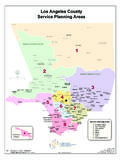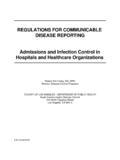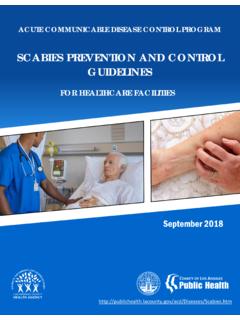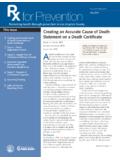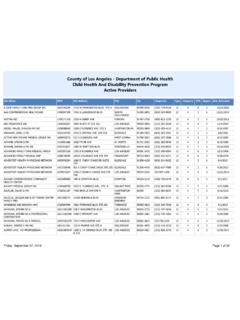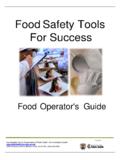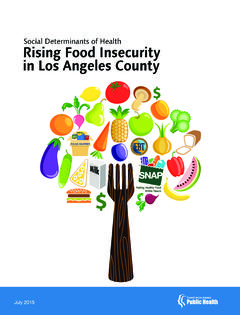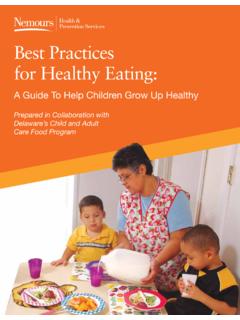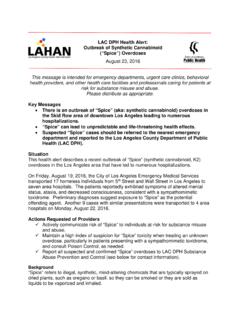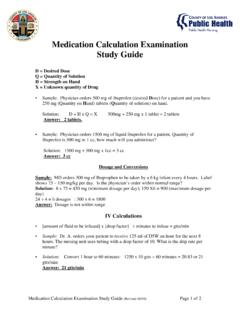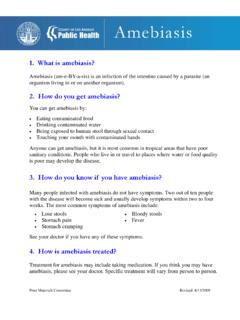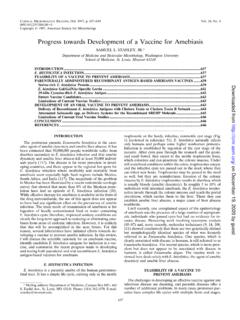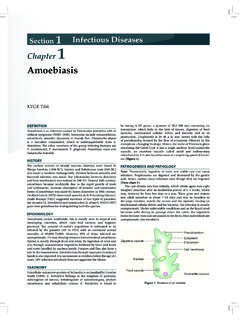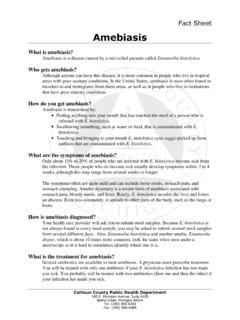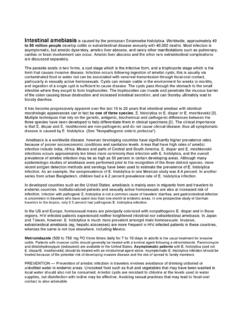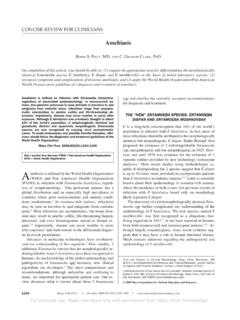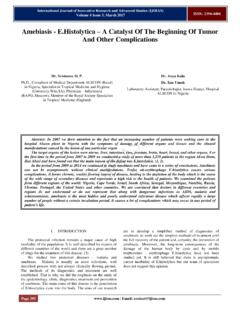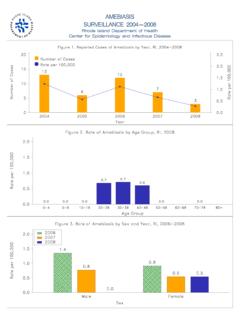Transcription of AMEBIASIS - Department of Public Health
1 Acute Communicable Disease Control Manual (B-73) REVIEWED October 2018 PART IV: Acute Communicable Diseases AMEBIASIS page 1 AMEBIASIS 1. Agent: Entamoeba histolytica, a protozoan parasite that exists as a trophozoite and cyst. A related non-pathogenic strain is distinct epidemiologically and biologically from the pathogenic species; this has been renamed Entamoeba dispar. E. dispar is not pathogenic in humans. E. histolytica is not to be confused with non-pathogenic protozoa found commonly in humans, which require no treatment. These include E. dispar, E. hartmanni, E. coli, E. polecki, Iodamoeba butschlii, Endolimax nana, Chilomastix mesnili, Trichomonas hominis, Retortamonas species, Enterom-onas species, and usually, Blastocystis hominis.
2 2. Identification: a. Symptoms: Depend on site. Intestinal: There are four distinct intestinal clinical syndromes with E. histolytica. Asymptomatic colonization (cyst pas-sage), acute amebic colitis, fulminant colitis, and ameboma. Asymptomatic cyst passage usually resolves without treatment; many such cases actually may have E. dispar. Patients with acute amebic colitis present with lower abdominal pain and have had frequent bloody stools over a period of several weeks; only about 1/3 have fever. Fulminant colitis is an uncommon presentation, most commonly seen in children. There is diffuse abdominal pain, profuse bloody diarrhea, and fever; concurrent liver abscess is common, and 3/4 may develop colonic perforations.
3 Ameboma is a rare (1%) manifestation that may be without symptoms, or present as a tender mass accompanied by symptomatic dysentery. Extra-intestinal: Amebic liver abscess, with either an acute clinical course with symptoms of <10 days, or a subacute course with symptoms lasting up to 6 months. Other sites of involvement include pleura, peritoneum, pericardium, and brain. b. Differential Diagnosis: Other bacterial, parasitic and viral causes of gastrointestinal illness. Amebic liver abscess should be differentiated from pyogenic abscess. 3. Incubation period: Variable, a few days to months; commonly 2-4 weeks. 4. Reservoir: Humans. 5. Source: Cysts from feces of infected case. 6. Transmission: Direct fecal-oral transmission, sexual transmission, ingestion of fecally contaminated food or water, colonic irrigation.
4 7. Communicability: Variable, as long a carrier state persists. 8. Specific Treatment: Consult the Medical Letter or Pediatric Red Book for specific drugs and dosages. Only E. histolytica requires treatment, but since most laboratories do not perform the test to distinguish it from E. dispar, treatment is commonly given to all persons with cysts or trophozoites of E. histolytica / dispar complex. Symptomatic AMEBIASIS should be treated with a systematically-active compound such as metronidazole, followed by a luminal amebicide to eliminate any surviving organisms in the colon. Metronidazole is not recommended for use during the first trimester of pregnancy. Asymptomatic carriers should be treated with a luminal amebicide in order to reduce the risk of transmission and protect the patient from symptomatic AMEBIASIS .
5 9. Immunity: None. REPORTING PROCEDURES 1. Reportable: (Title 17, Section 2500, California Code of Regulations.) Report within 1 working day of identification of a case or suspected case. Acute Communicable Disease Control Manual (B-73) REVIEWED October 2018 PART IV: Acute Communicable Diseases AMEBIASIS page 2 2. Case Definitions: Confirmed, intestinal AMEBIASIS : a clinically compatible illness that is laboratory confirmed. Confirmed, extraintestinal AMEBIASIS : a parasitologically confirmed infection of extraintestinal tissue, or among symptomatic persons (with clinical or radiographic findings consistent with extraintestinal infection), demonstration of specific antibody against E. histolytica as measured by indirect hemagglutination or other reliable immunodiagnostic test ( , enzyme-linked immunosorbent assay).
6 3. Report Form: PARASITE EPIDEMIOLOGIC CASE HISTORY FORM (acd-parasite)1 PARASITE CONTACT ROSTER2 4. Epidemiologic Data: Only symptomatic persons with suspected gastrointestinal and/or extra-intestinal AMEBIASIS with laboratory- evidence of E. histolytica should be reported to Public Health and have waterborne disease case report completion. Persons who have been reported with asymptomatic colonization of Entamoebae sp. should be closed as false cases. a. Indicate whether case is: Acute ( , diarrhea within the past 4 weeks), chronically symptomatic, or asymptomatic carrier. Intestinal or extra-intestinal ( , liver, lung abscess or other). b. Sexual orientation. c. History of colonic irrigation, when and where. d. Immigration from or travel to a developing country within 6 months prior to onset.
7 Specific dates and places. 1 2 3 e. Exposure to carrier and other persons with diarrheal illness within incubation period. f. Occupation of case and household mem-bers. g. Residence in facility for the developmentally disabled. h. Attendance in day care. CONTROL OF CASE, CONTACTS (See Table 1) & CARRIERS Contact within 24 hours to determine if sensitive occupation or situation (SOS) involved. Otherwise, investigate within 3 days. Public Health Nursing Home Visit Protocol: Home visit as necessary a face to face interview is conducted as necessary. Refer to Public Health Nursing Home Visit AS NECESSARY (HVAN) Algorithm (B-73 Part IV Public Health Nursing Home Visit Protocol)3.
8 CASE: Precautions: Enteric precautions until clinical recovery. 1. Sensitive Occupations or Situations: a. Food handler Currently Symptomatic: Restrict/exclude until 3 consecutive stool specimens, taken at intervals of not less than 3 days apart are negative. Previously Symptomatic in the Past 48-72 Hours: Restrict/exclude until 3 consecutive stool specimens taken at intervals of not less than 3 days apart are negative. b. Other Currently Symptomatic: Restrict/exclude until 48 hours after resolution of signs and symptoms. No clearance required. Previously Symptomatic in the Past 48-72 Hours: No restriction. Acute Communicable Disease Control Manual (B-73) REVIEWED October 2018 PART IV: Acute Communicable Diseases AMEBIASIS page 3 2.
9 Child 5 years in group setting: Currently Symptomatic: Restrict/exclude until 48 hours after resolution of signs and symptoms. No clearance required. Previously Symptomatic in the Past 48-72 Hours: May return to group care if asymptomatic for 48 hours. 3. Non-sensitive Occupations or Situations: Release after clinical recovery unless household contacts are food handler. CONTACTS: Household members or persons who share a common source. 1. Sensitive Occupations or Situations: a. Food handler Currently Symptomatic: Collect one stool specimen for testing in a PHL. Restrict/exclude until stool testing negative. Asymptomatic: No restriction. b. Other Currently Symptomatic: Collect one stool specimen for testing in a PHL.
10 Restrict/exclude until stool testing negative. Asymptomatic: No restriction. 2. Child 5 years in group setting: Currently Symptomatic: Collect one stool specimen for testing in a PHL. Restrict/exclude until stool testing negative. Asymptomatic: No restriction. 3. Non-sensitive Occupations or Situations: No action. CARRIERS: Refer for treatment. Release as for case. PREVENTION-EDUCATION 1. Stress hand washing and personal hygiene. 2. Educate about increased risk with anal and oral-anal sex. 3. Dispose of feces in a safe, sanitary fashion. 4 4. Take precautions with food and water when traveling to endemic areas. 5. Advice regarding risk associated with colonic irrigation. 6.
